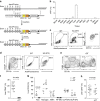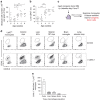Bone marrow-derived monocytes give rise to self-renewing and fully differentiated Kupffer cells
- PMID: 26813785
- PMCID: PMC4737801
- DOI: 10.1038/ncomms10321
Bone marrow-derived monocytes give rise to self-renewing and fully differentiated Kupffer cells
Abstract
Self-renewing tissue-resident macrophages are thought to be exclusively derived from embryonic progenitors. However, whether circulating monocytes can also give rise to such macrophages has not been formally investigated. Here we use a new model of diphtheria toxin-mediated depletion of liver-resident Kupffer cells to generate niche availability and show that circulating monocytes engraft in the liver, gradually adopt the transcriptional profile of their depleted counterparts and become long-lived self-renewing cells. Underlining the physiological relevance of our findings, circulating monocytes also contribute to the expanding pool of macrophages in the liver shortly after birth, when macrophage niches become available during normal organ growth. Thus, like embryonic precursors, monocytes can and do give rise to self-renewing tissue-resident macrophages if the niche is available to them.
Figures







Similar articles
-
Healthcare workers' informal uses of mobile phones and other mobile devices to support their work: a qualitative evidence synthesis.Cochrane Database Syst Rev. 2024 Aug 27;8(8):CD015705. doi: 10.1002/14651858.CD015705.pub2. Cochrane Database Syst Rev. 2024. PMID: 39189465 Free PMC article.
-
Depressing time: Waiting, melancholia, and the psychoanalytic practice of care.In: Kirtsoglou E, Simpson B, editors. The Time of Anthropology: Studies of Contemporary Chronopolitics. Abingdon: Routledge; 2020. Chapter 5. In: Kirtsoglou E, Simpson B, editors. The Time of Anthropology: Studies of Contemporary Chronopolitics. Abingdon: Routledge; 2020. Chapter 5. PMID: 36137063 Free Books & Documents. Review.
-
Far Posterior Approach for Rib Fracture Fixation: Surgical Technique and Tips.JBJS Essent Surg Tech. 2024 Dec 6;14(4):e23.00094. doi: 10.2106/JBJS.ST.23.00094. eCollection 2024 Oct-Dec. JBJS Essent Surg Tech. 2024. PMID: 39650795 Free PMC article.
-
Using Experience Sampling Methodology to Capture Disclosure Opportunities for Autistic Adults.Autism Adulthood. 2023 Dec 1;5(4):389-400. doi: 10.1089/aut.2022.0090. Epub 2023 Dec 12. Autism Adulthood. 2023. PMID: 38116059 Free PMC article.
-
Trends in Surgical and Nonsurgical Aesthetic Procedures: A 14-Year Analysis of the International Society of Aesthetic Plastic Surgery-ISAPS.Aesthetic Plast Surg. 2024 Oct;48(20):4217-4227. doi: 10.1007/s00266-024-04260-2. Epub 2024 Aug 5. Aesthetic Plast Surg. 2024. PMID: 39103642 Review.
Cited by
-
Transcriptome-based profiling of yolk sac-derived macrophages reveals a role for Irf8 in macrophage maturation.EMBO J. 2016 Aug 15;35(16):1730-44. doi: 10.15252/embj.201693801. Epub 2016 Jul 13. EMBO J. 2016. PMID: 27412700 Free PMC article.
-
Macrophages and scavenger receptors in obesity-associated non-alcoholic liver fatty disease (NAFLD).Scand J Immunol. 2020 Nov;92(5):e12971. doi: 10.1111/sji.12971. Epub 2020 Sep 21. Scand J Immunol. 2020. PMID: 32892401 Free PMC article. Review.
-
Noncoding RNA-mediated macrophage and cancer cell crosstalk in hepatocellular carcinoma.Mol Ther Oncolytics. 2022 Mar 16;25:98-120. doi: 10.1016/j.omto.2022.03.002. eCollection 2022 Jun 16. Mol Ther Oncolytics. 2022. PMID: 35506150 Free PMC article. Review.
-
Nature and nurture of tissue-specific macrophage phenotypes.Atherosclerosis. 2019 Feb;281:159-167. doi: 10.1016/j.atherosclerosis.2018.10.005. Epub 2018 Oct 6. Atherosclerosis. 2019. PMID: 30343819 Free PMC article. Review.
-
Liver-Derived Signals Sequentially Reprogram Myeloid Enhancers to Initiate and Maintain Kupffer Cell Identity.Immunity. 2019 Oct 15;51(4):655-670.e8. doi: 10.1016/j.immuni.2019.09.002. Epub 2019 Oct 3. Immunity. 2019. PMID: 31587991 Free PMC article.
References
-
- Schulz C. et al.. A lineage of myeloid cells independent of Myb and hematopoietic stem cells. Science 336, 86–90 (2012). - PubMed
Publication types
MeSH terms
LinkOut - more resources
Full Text Sources
Other Literature Sources
Molecular Biology Databases

